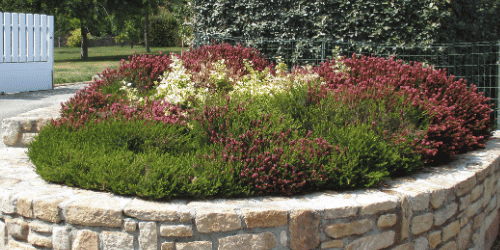Stone borders are not only aesthetically pleasing but also functional. They define garden beds, pathways, and other outdoor spaces. In this blog post, we’ll explore the steps to build durable stone borders that can withstand heavy foot traffic. Whether you’re a homeowner or a landscaper, these tips will help you create lasting stone features.
Stone borders serve both practical and decorative purposes. By choosing the right materials and following proper installation techniques, you can ensure longevity and stability.
Selecting the Right Stone
Types of Stone
Various types of stone suitable for borders include flagstone, limestone, and granite, each offering unique benefits. Flagstone provides a flat surface with natural, earthy tones and varied textures, making it ideal for garden paths and borders. Limestone, known for its light color and smooth texture, adds a classic look and is durable against weathering. Granite, with its speckled appearance and range of colors, is extremely durable and perfect for high-traffic areas. For McKinney, TX, flagstone and limestone are recommended due to their ability to withstand hot, dry summers and mild winters, while granite, though more expensive, offers long-lasting resilience against weather extremes.
Stone Size and Shape
The size of the stone affects its stability. Larger stones are generally more stable than smaller ones. Irregular shapes can lock together better, creating a more natural look. Uniform cuts are easier to arrange and fit neatly. For small projects like garden borders, use medium-sized stones. For larger projects, like retaining walls, use big stones for better stability. Choose the right stone size based on the specific needs of your project to ensure it looks good and stays strong.
Preparing the Ground
A solid base is crucial for any stone project. Start by excavating the area to the needed depth. Then, level the soil to create an even surface. Next, compact the soil to ensure stability. This prevents stones from shifting or settling over time. Using landscape fabric over the compacted soil helps prevent weed growth. This keeps your stone work looking neat and reduces maintenance. A well-prepared base ensures your project is durable and long-lasting.
Installation Techniques
Dry-Laid vs. Mortared
Dry-laid and mortared stone borders each have their advantages and disadvantages. Dry-laid borders, built without mortar, are easier to install and adjust, allowing for natural drainage and flexibility, but they may shift over time and need occasional maintenance. Mortared borders, using cement to hold stones in place, offer greater stability and durability, with less likelihood of shifting, but require more skill, time, and are harder to adjust once set. For dry-laid borders, excavate, level, compact the soil, lay a base of gravel or sand, and fit the stones tightly. For mortared borders, excavate, compact the soil, possibly lay a concrete footing, apply mortar, place the stones, fill gaps with mortar, and allow it to cure. The choice depends on your project’s needs and your skill level.
Base Material
Using crushed gravel or sand as a base is essential for stability. Start with a proper depth of about 4-6 inches, depending on your project. Spread the material evenly and compact it thoroughly to create a solid foundation. Compaction can be done using a hand tamper or a plate compactor. Ensure the base is level to prevent shifting. For added stability, consider adding a layer of landscape fabric beneath the gravel or sand to prevent weed growth and soil movement. This preparation ensures a durable and stable base for your stone project.
Laying the Stones
To arrange stones in a visually pleasing pattern, start by planning the layout. Overlapping joints create a more natural look, while tight joints offer a neater appearance. Begin with the largest stones and place them first, ensuring they are level. Use smaller stones to fill gaps. Check the alignment regularly with a string line or level to keep the pattern consistent. Adjust stones as needed to maintain levelness and ensure the joints fit well together. This careful placement results in a balanced and attractive stone arrangement.
Finishing Touches
Edging
Edging is important for keeping stones in place and maintaining the border’s shape. It prevents stones from shifting and helps define the landscape. Edging options include metal, plastic, or stone. Metal edging is durable and offers a sleek look, plastic is flexible and easy to install, and stone edging blends naturally with the landscape. To secure the edging, dig a trench along the border, place the edging in the trench, and backfill with soil to hold it in place. For metal and plastic edging, use stakes or pins for added stability. Properly installed edging ensures a neat, lasting border.
Joint Filling
Filling gaps between stones is important for stability and appearance. Use sand for flexibility and water drainage in dry-laid projects. Gravel provides a rustic look and aids in drainage as well. Mortar offers a solid, permanent fill, ensuring stones remain securely in place but requires more skill to apply. For maintenance, periodically add sand or gravel to settle gaps over time. Mortared joints may need occasional inspection and repair for long-term durability. Choose based on your project’s design and maintenance needs to ensure both visual appeal and structural stability.
Sealing
Sealing stone borders provides benefits like protecting against stains, moisture, and UV damage, which keeps them looking good longer. Recommended sealants include penetrating sealers for natural stone that absorb into the stone without changing its appearance, and topical sealers for adding color enhancement and gloss. To apply, start with a clean, dry surface. Use a brush, roller, or sprayer to coat the stones and joints evenly with the sealer. Let it soak in and dry according to the instructions. Apply multiple coats if needed and reapply regularly to maintain protection. Sealing stone borders helps maintain their durability and natural beauty over time.
Answering Common Questions
Q1Can I build stone borders on a slope?
A1 Yes, but proper leveling and base preparation are crucial. Consider terracing if the slope is significant.
Q2 How do I prevent weeds from growing between the stones?
A2 Landscape fabric under the base helps, but periodic weeding is essential.
Q3 Should I hire a professional or DIY?
A3 DIY is possible, but professional expertise ensures better results.
The Impact of Local Climate
McKinney, TX experiences hot summers and occasional heavy rain. Choose stone types that can withstand temperature fluctuations and moisture.
Stone Borders and Curb Appeal
Stone borders enhance curb appeal, adding value to your property. Consider them an investment in aesthetics and functionality.
Seeking Expert Advice
While this guide provides valuable insights, consult with a local landscaper or stonemason for personalized advice. They can recommend the best materials and techniques based on your specific needs.
Conclusion
In conclusion, creating durable stone borders involves a thoughtful process that balances aesthetics, functionality, and longevity. By following the right steps, you can enhance your outdoor spaces while ensuring that your stone borders withstand the test of time.
Begin by choosing the right type of stone based on your climate, personal preferences, and project requirements. Consider factors like durability, color, and texture. Remember that local conditions play a significant role in determining the best stone for your borders.
Whether you opt for a dry-laid or mortared approach, focus on a solid base. Excavate, level, and compact the ground thoroughly. Laying the stones with precision ensures stability and prevents shifting over time.
Edging, joint filling, and sealing are the finishing touches that elevate your stone borders. Edging materials keep everything in place, joint filling prevents weed growth, and sealing protects against weathering.
Visit Us At Tailor Made
For more information and personalized guidance, visit us at Tailor Made Contracting is here to provide you with exceptional landscape design services that transform your outdoor space into a work of art. Whether you’re dreaming of a lush garden, a tranquil patio, or a vibrant play area, we’ll bring your vision to life. Contact us today and let’s create something extraordinary together!







